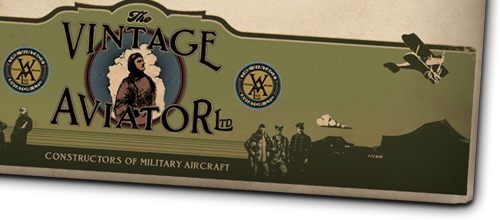You are here
RAF.1a History
"The R.A.F. 1a engine is of the stationary air cooled V-type engine of eight cylinders. This engine is an improved version of the French Renault."
The improvements consisted of mounting the crankshaft and camshaft on ball and roller bearings and casting the cylinders in one piece, rather than joining cylinder head to barrel as on the Renault. The engine is rated at 90 H.P. but is capable of developing some 100 H.P. at 1800 R.P.M. This engine design was essentially the first “Standardized” engine that would be manufactured and then inspected by the A.I.D. (Aircraft Inspection Department)
R.A.F. 1a Engine Breakdown
The crankcase is of aluminum alloy and is in three main parts, the upper portion, the lower part or sump and a large end plate or flywheel cover. At the propeller end of the crankcase is a smaller end plate which forms a cover for the gearbox and a housing for the front propeller shaft radial ball race and thrust race (the engine has no double thrust bearing and cannot be used as a pusher).
Crankshaft
(The crankshaft is made of forged steel. It is hollow and has four throws arranged in pairs at 180 degrees to each other, it runs on four roller bearings and one ball bearing. A helical groove around the flywheel boss serves as a baffle to prevent oil from escaping where the crankshaft passes through the flywheel cover.
Propeller Shaft
A short hollow propeller shaft is mounted above the crankshaft at the end opposite the flywheel, and is driven direct through the spur gearing at half the engine speed. The propeller shaft runs on two radial ball bearings, and is fitted with a thrust bearing arranged for tractor working.
Cylinders
The cylinders are of cast iron with cooling ribs. Each cylinder is held in position by two long mild steel rods or “studs” which are screwed into the crankcase and pass through projecting lugs at the top of the cylinder. The tops of these rods are screwed to take castellated nuts, which bear upon the lugs and draw the cylinders up to the crankcase, where they rest on small flanges turned on the cylinder base.
Pistons
The pistons are of cast iron with slightly convex heads, and each piston carries three cast iron rings.
Connecting Rods
Made of special alloy steel and “H” design section, bronze bushed at the small end and white metal at the big end.
Carburation
The induction system consists of a double Claudel Hobson carburetter bolted to the engine's rear flywheel cover. From the rear cover, intake gasses travel through copper intake tube sections joined by rubber connectors each servicing a separate cylinder. This arrangement makes removing a cylinder very easy and also allows for some flexibility as engine components expand and contract. A piston-type air pump is placed directly between the cylinders on the crankcase top half to supply compressed air for pressurizing the aircraft fuel tank. This pump is worked by a cam on the camshaft.
Engine Lubrication
Lubrication is chiefly by splash. The flywheel which is situated at the rear of the engine is enclosed and revolves partly submerged in oil. The oil is carried round on the rim of the flywheel until it reaches the top of the crankcase, where it is thrown into an oil passage that leads the oil into an oil duct running the full length of the crankcase. From this duct two pipes lead the oil to the base of the second and fourth main crankshaft bearings, where it immediately overflows into oil banjoes. These banjoes pass the oil through the crank web into the hollow crank pin and thence out of holes in same, lubricating the big ends of the connecting rods. The overflow from the big ends is caught up by the crankshaft and thrown into the interior of the cylinder, thus lubricating the cylinders, pistons and gudgeon pins. All the bearings on the crankshaft, camshaft, tappets, cams, cam guides and other internal parts are oiled by splash. Two breathers are placed at the propeller end of the sump to relieve the backpressure in the crankcase. Three exits of the same are placed so that if by any chance oil is blown through - it is blown onto the exhaust tappet rockers and springs. The valve rockers, springs, magnetos, and other external parts are oiled by hand preparatory to flight.
notes & Specifications
Specifications:
Interesting Notes:
Oil Should be drained from sump and sump cleaned after 20 hours flying.
The valves and pistons should be examined, cleaned and reground if necessary after 50 Hours flying.
The class of oil used is Sternol, or a mixture of Vacuum A and B in equal quantities.
The sump will hold 25 pints of oil for normal flights, but a further five pints may be added if a long flight is contemplated.
Most engines are fitted with two magnetos of the four cylinder type but new engines will incorporate one B.T.H. Type A8, eight cylinder magneto.
An oil gauge or ball float indicator is fitted to the sump to register the amount of oil contained.
from “TECHNICAL NOTES, R.F.C.” London 1916



